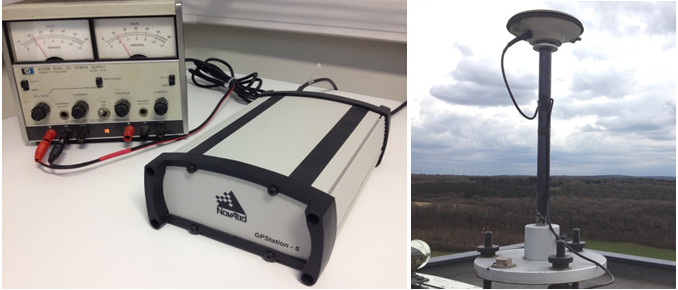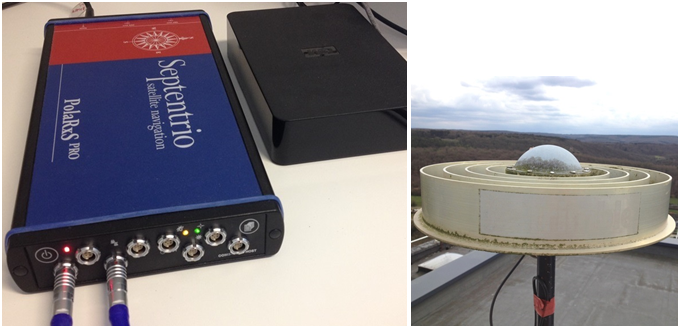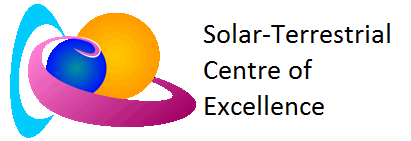GNSS Receivers
GNSS signals provide useful means for global and continuous ionospheric monitoring. With a specialised GNSS receiver it is possible to deduce important ionospheric characteristics, such as the Total Electron Content (TEC) and small-scale ionospheric irregularities causing GNSS signal scintillations in phase and amplitude. TEC is measured using combinations of multi-frequency GNSS signals while for ionospheric scintillations, the standard measures are the S4 index for amplitude variations and the sigma-phi (σφ) index for phase variations.
Currently, there are several GNSS signal receivers available at the RMI Geophysical Centre in Dourbes (50.1°N, 4.6°E) to facilitate our ionospheric research activities.
NovAtel GPStation-6™

NovAtel GPStation-6™ is a high-performance GNSS Ionospheric Scintillation and TEC Monitor (GISTM) (NovAtel, 2011; Shanmugam et al., 2012).
The GPStation-6 receiver can track all present and upcoming GNSS constellations and satellite signals with a maximum sampling rate of 50 Hz for each of the 120 available tracking channels (NovAtel, 2012). It incorporates the NovAtel's multi-constellation, multi-frequency OEM628™ GNSS measurement engine and an ultra-low noise OCXO (Oven Controlled Crystal Oscillator).
The performance of a traditional GNSS receiver is degraded during ionospheric disturbances, and as a result, signal measurements by such receivers do not allow for observation (or characterisation) of how ionospheric disturbances affect the tracked signals. A major limitation of a traditional GNSS receiver (when it comes to ionospheric measurements) is the high phase noise of the onboard temperature controlled crystal oscillator (TCXO). The GPStation-6 receiver removes this limitation by utilising an ultra-stable, low phase noise OCXO. Thus, using the high-quality 10 MHz reference signal generated by the OCXO, the OEM628 measurement engine is capable of generating the precise phase measurements required to observe phase scintillations.
The GPStation-6 outputs a variety of signal measurements and statistics useful for characterizing the local ionospheric environment. The receiver independently samples the raw amplitude and phase of each tracked signal at a high-rate (50 Hz) and outputs these raw 50 Hz measurements every second. Raw TEC measurements are also output every second. These raw measurements are also processed (detrended) within the GPStation-6 receiver to produce 60-second summary logs (scintillation, TEC). The summary logs contain measurement data (C/No, code-minus-carrier, lock time, etc.) and smoothed ionospheric measurements based on the raw data to provide valuable insight into the ionospheric conditions for each signal tracked over the past minute.
The GISTM configuration includes an active triple-frequency NovAtel Pinwheel™ antenna, GPS-703-GGG (NovAtel, 2011b). The GPS-703-GGG antenna receives L1, L2, and L5 GNSS frequencies and offers combined GPS+GLONASS+GALILEO signal reception. Since the phase centre of this antenna remains constant as the azimuth and elevation angle of GNSS satellites change, the signal reception is unaffected by the rotation of the antenna or the satellite elevation. With the phase centre in the same location for the L1, L2 and L5 signals, and with minimal phase centre variation between antennas, GPS-703-GGG is ideal for baselines of any length.
Our GPStation-6 GISTM, co-located with the digital ionospheric sounder at the RMI Geophysical Centre in Doubes (50.1°N,4.6°E), is exclusively used in the operation of the local ionospheric specification and visualisation system LIEDR (Stankov et al., 2011). The local TEC measurements can be found here.
Septentrio PolaRxS™

Septentrio PolaRxS™ is a multi-frequency multi-constellation GNSS receiver (Septentrio, 2010, 2011, 2012) designed around a state-of-the-art ultra-low noise Oven-Controlled Crystal Oscillator (OCXO) and Septentrio's latest multi-frequency tracking engine. PolaRxS provides high-quality GPS, GLONASS and GALILEO tracking next to a range of innovative features such as AIM (Adaptive Interference analysis and Mitigation), APME (A Posteriori Multipath Estimation) for tackling short-delay multipath, or LOCK for robust tracking of rapid signal dynamics during scintillation events. Post-correlation phase and signal intensity are made available at up to 100 Hz for direct use or post-processed by the provided graphical user interface to derive and record TEC and scintillation indices.
Our PolaRxS configuration includes a Trimble choke ring antenna which can tracks all existing and planned GNSS constellations. When multipath signals are present, the antenna reduces the multipath effects thanks to its extended ground plane which impedes multipath signals that reflect off of surfaces below the antenna from entering the receiving element. The scientific standard JPL (Jet Propulsion Laboratory) choke ring design, combined with the Trimble-exclusive Dorne-Margolin dipole element, reflects these signals away from the antenna. The TEC obtained from this receiver can be found here.
Septentrio PolaRx4™

Septentrio PolaRx4™ is a multi-frequency GNSS reference receiver providing network operators and scientific users with high-quality tracking and measurement of all available and upcoming GNSS signals. Innovative signal processing, extensive networking capabilities, a robust design and an intuitive user interface make the receiver an excellent choice as future-proof base station solution.
The PolaRx4 receiver is combined with a Leica AR25 choke ring antenna with an innovative 3D design using a new ultra-wideband Dorne-Margolin element. Leica AR25 maintains high levels of multipath rejection and tracking expected from a choke ring antenna, whilst setting new standards in low-elevation tracking compared to the traditional 2D choke ring design.
This is an EUREF station (DOUR00BEL) managed by the Royal Observatory of Belgium.
References:
NovAtel (2011a): GPStation-6™, GNSS Ionospheric Scintillation and TEC Monitoring (GISTM) Receiver—User Manual, OM-20000132, NovAtel.
NovAtel (2011b): GPS-703-GGG, Triple Frequency Pinwheel™ Antenna Maximizes Tracking Capabilities. NovAtel GPS-703-GGG Technical Specifications, Version 4, NovAtel. (download)
NovAtel (2012): GPStation-6™, Next Generation High-Performance GNSS Ionospheric Scintillation and TEC Monitor (GISTM) Receiver Enclosure with Low Phase Noise Oscillator. NovAtel GPStation-6 Technical Specifications, Version 2, NovAtel. (download)
Septentrio (2010): PolaRxS Product Family Hardware Manual, Version 1.0.0, 11 pages, Septentrio nv/sa.
Septentrio (2011): PolaRxS Application Manual, Version 2.2.0, 22 pages, Septentrio nv/sa.
Septentrio (2012): PolaRxS Technical Specifications, Septentrio nv/sa. (download)
Shanmugam, S., Jones, J., MacAulay, A., Van Dierendonck, A.J. (2012): Evolution to modernized GNSS ionospheric scintillation and TEC monitoring. in: Proc. IEEE/ION PLANS, 24-26 April 2012, Myrtle Beach, SC, USA. (download)
Stankov, S.M., Stegen, K., Muhtarov, P., Warnant R. (2011): Local ionospheric electron density profile reconstruction in real time from simultaneous ground-based GNSS and ionosonde measurements. Advances in Space Research, 47(7), 1172-1180, (doi:10.1016/j.asr.2010.11.039). (download)

